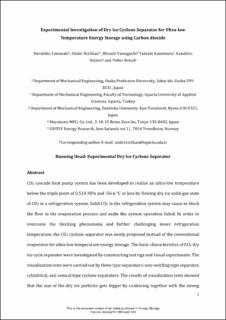| dc.contributor.author | Yamasaki, Haruhiko | |
| dc.contributor.author | Kizilkan, Ônder | |
| dc.contributor.author | Yamaguchi, Hiroshi | |
| dc.contributor.author | Kamimura, Takeshi | |
| dc.contributor.author | Hattori, Kazuhiro | |
| dc.contributor.author | Nekså, Petter | |
| dc.date.accessioned | 2021-07-14T09:51:32Z | |
| dc.date.available | 2021-07-14T09:51:32Z | |
| dc.date.created | 2021-02-15T14:50:07Z | |
| dc.date.issued | 2020 | |
| dc.identifier.issn | 2578-4862 | |
| dc.identifier.uri | https://hdl.handle.net/11250/2764369 | |
| dc.description.abstract | CO2 cascade heat pump system has been developed to realize an ultra‐low temperature below the triple point of 0.518 MPa and − 56.6°C or less by flowing dry ice solid‐gas state of CO2 in a refrigeration system. Solid CO2 in the refrigeration system may cause to block the flow in the evaporation process and make the system operation failed. To overcome the blocking phenomena and farther challenging lower refrigeration temperature, the CO2 cyclone separator was newly proposed instead of the conventional evaporator for ultra‐low temperature energy storage. The basic characteristics of CO2 dry ice cycle separator were investigated by constructing test rigs and visual experiments. The visualization tests were carried out by three type separators: nonswirling type separator, cylindrical, and conical type cyclone separators. The results of visualization test showed that the size of the dry ice particles gets bigger by coalescing together with the strong swirling flow in the cyclone separator. In comparison with three type separators, particularly by using the conical type cyclone separator, the amount of accumulation of dry ice at the bottom of the separator was increased as a result of the growth in dry ice particle size. | en_US |
| dc.language.iso | eng | en_US |
| dc.publisher | Wiley | en_US |
| dc.rights | Attribution-NonCommercial-NoDerivatives 4.0 Internasjonal | * |
| dc.rights.uri | http://creativecommons.org/licenses/by-nc-nd/4.0/deed.no | * |
| dc.title | Experimental investigation of dry ice cyclone separator for ultra‐low temperature energy storage using carbon dioxide | en_US |
| dc.type | Peer reviewed | en_US |
| dc.type | Journal article | en_US |
| dc.description.version | acceptedVersion | en_US |
| dc.source.volume | 2 | en_US |
| dc.source.journal | Energy Storage | en_US |
| dc.source.issue | 4 | en_US |
| dc.identifier.doi | 10.1002/est2.149 | |
| dc.identifier.cristin | 1889985 | |
| dc.relation.project | Norges forskningsråd: 257632 | en_US |
| dc.source.articlenumber | e149 | en_US |
| cristin.ispublished | true | |
| cristin.fulltext | original | |
| cristin.fulltext | postprint | |
| cristin.qualitycode | 1 | |

